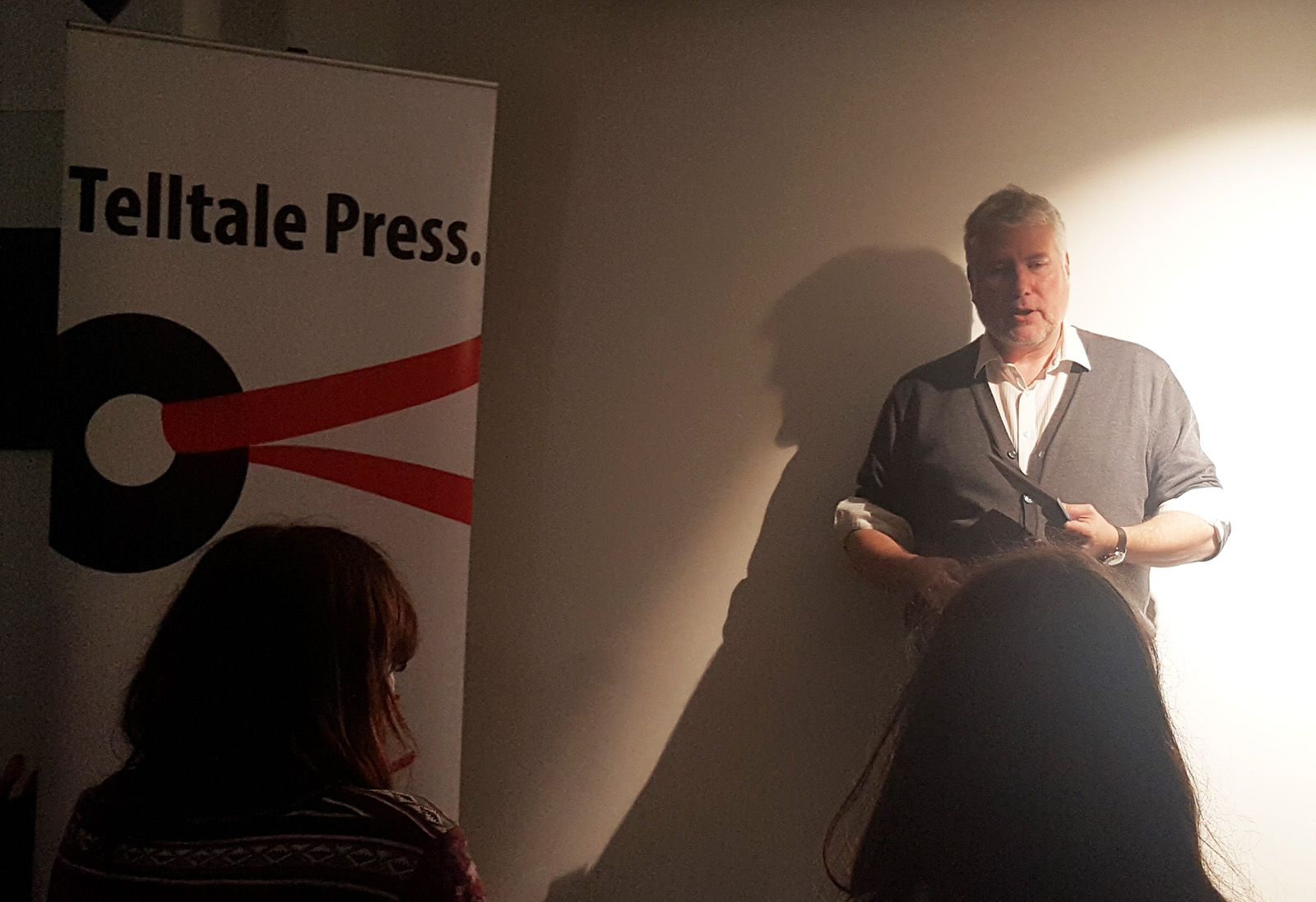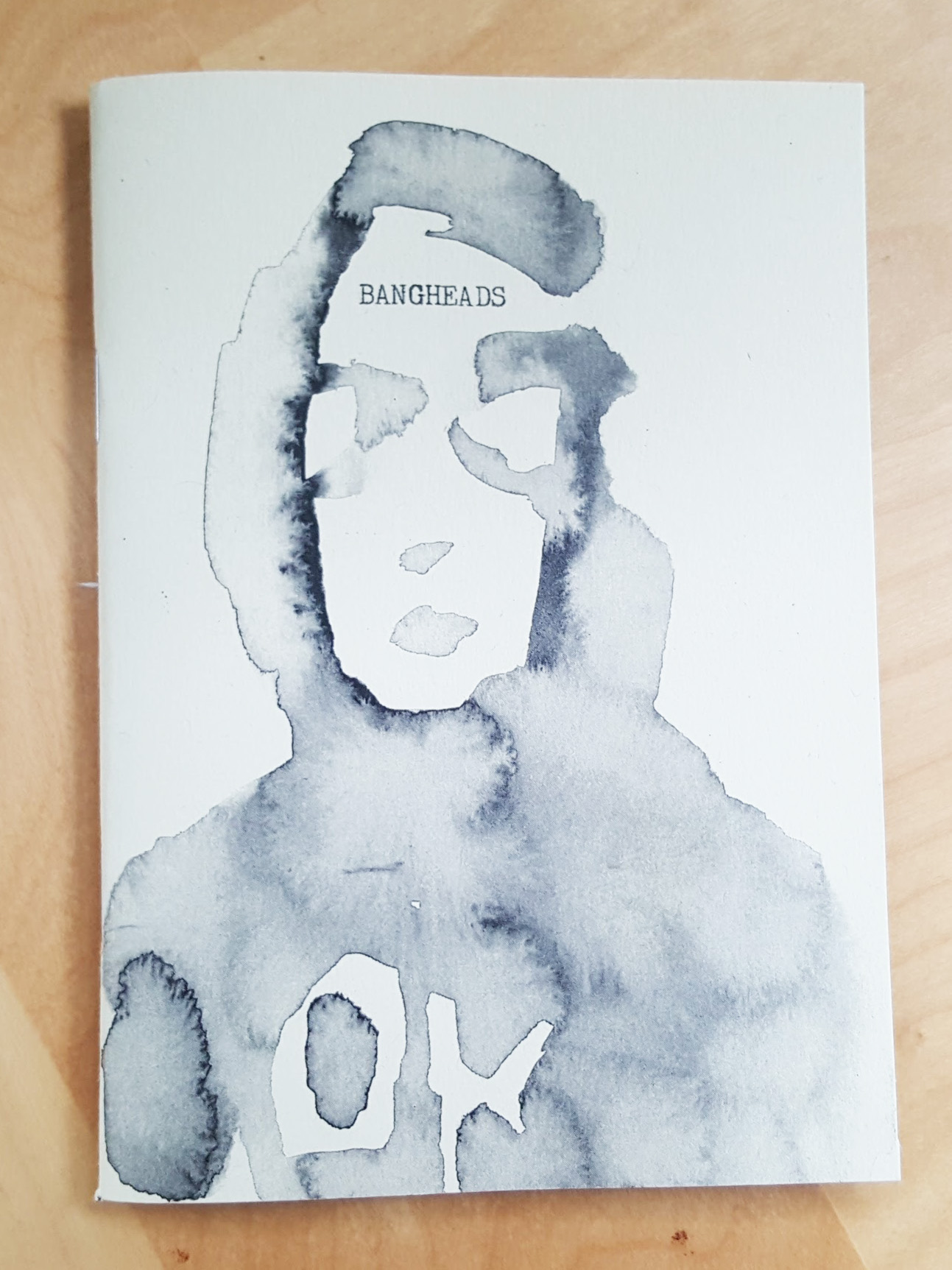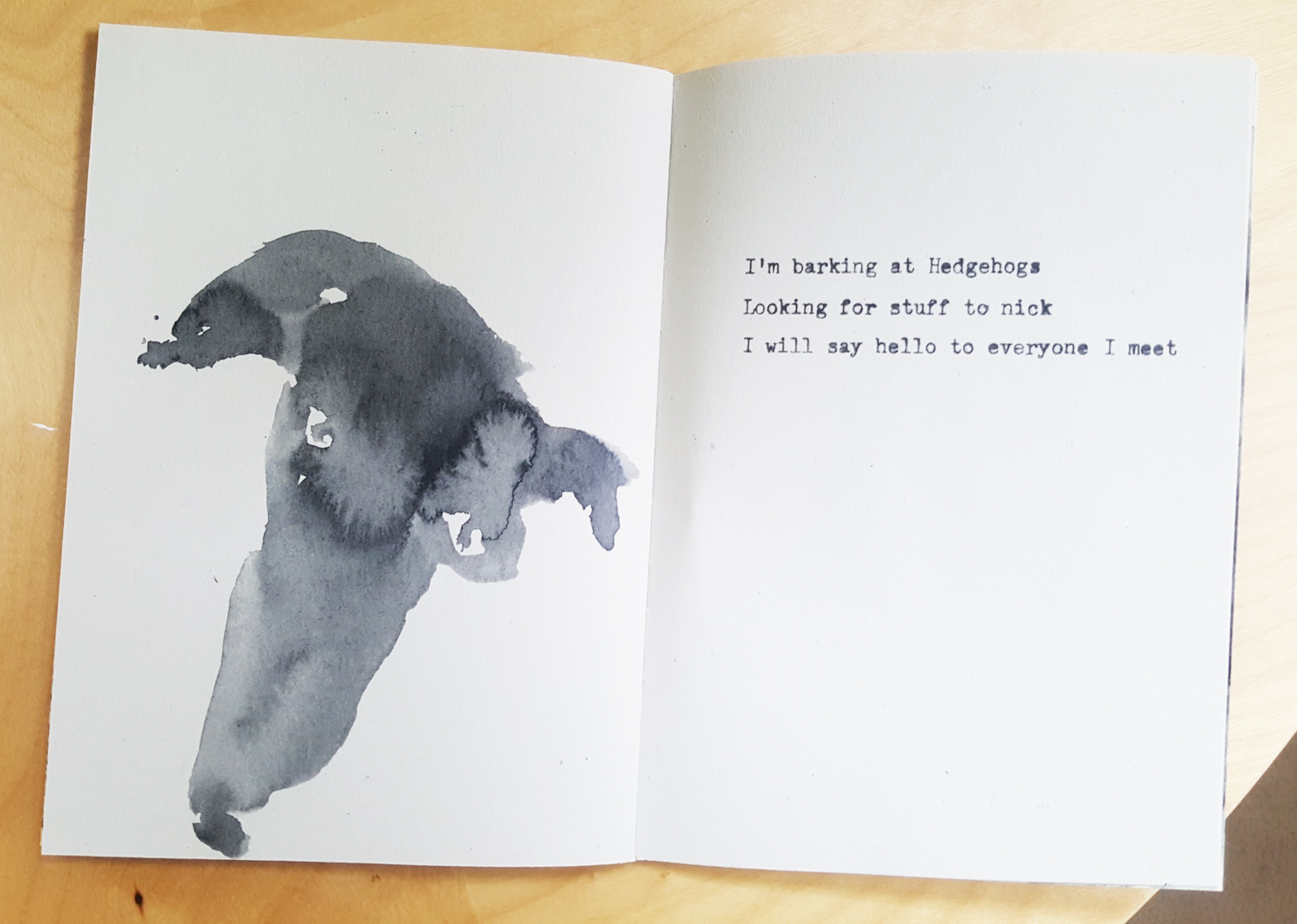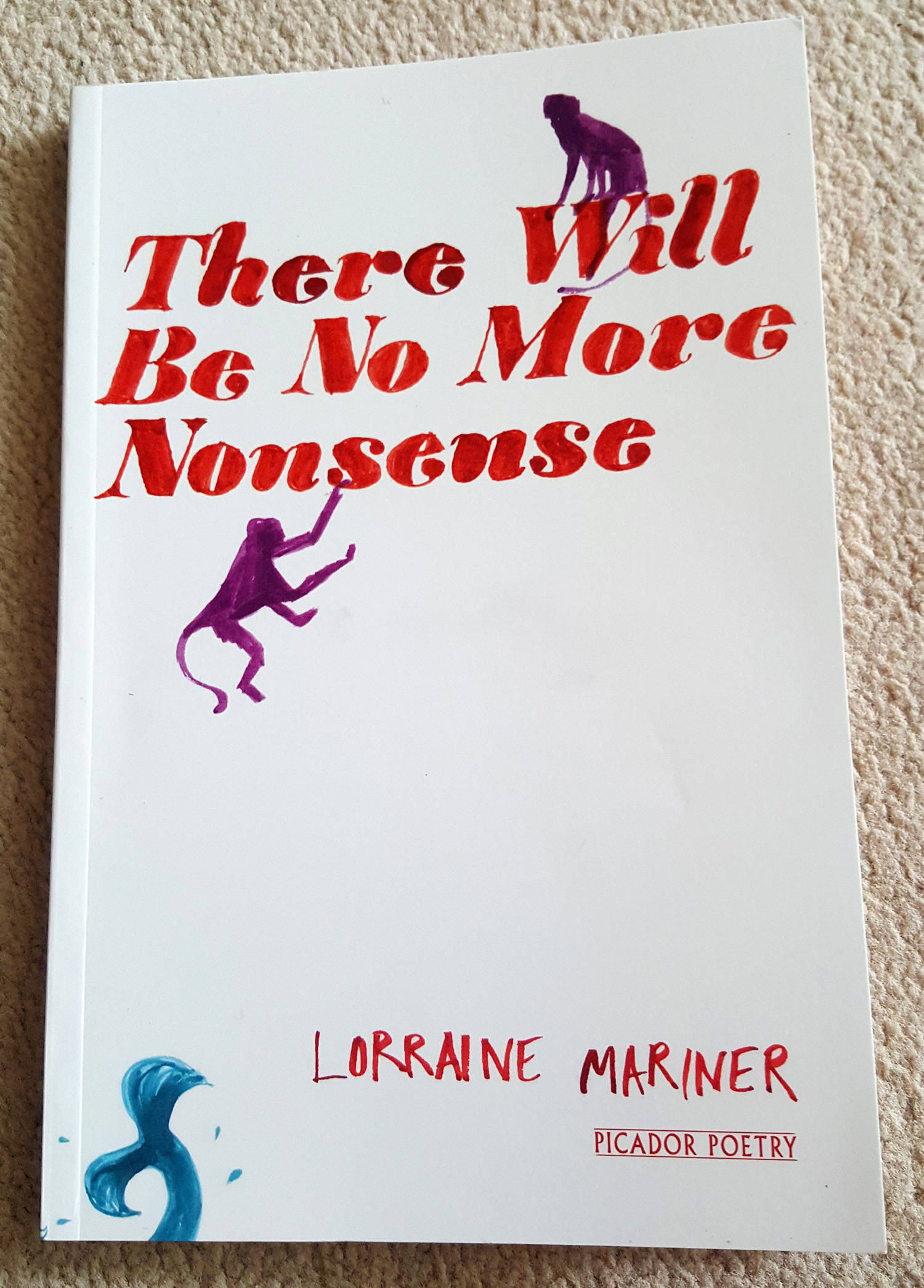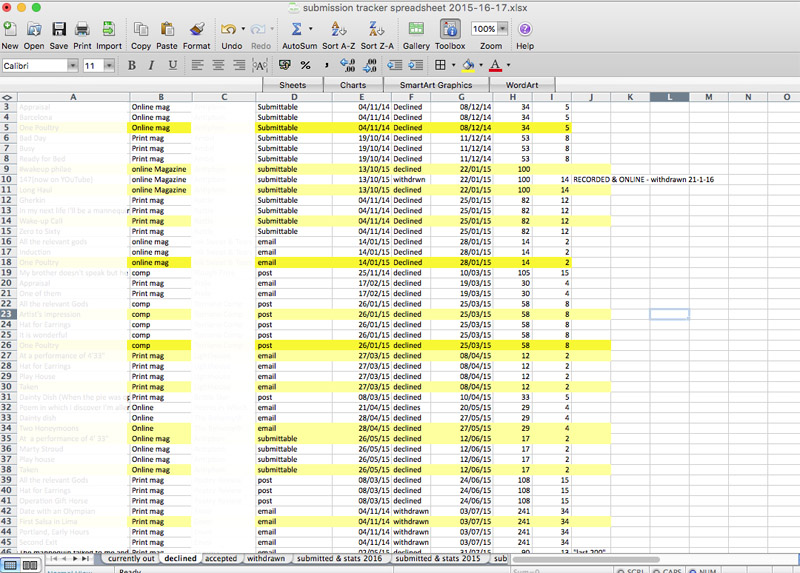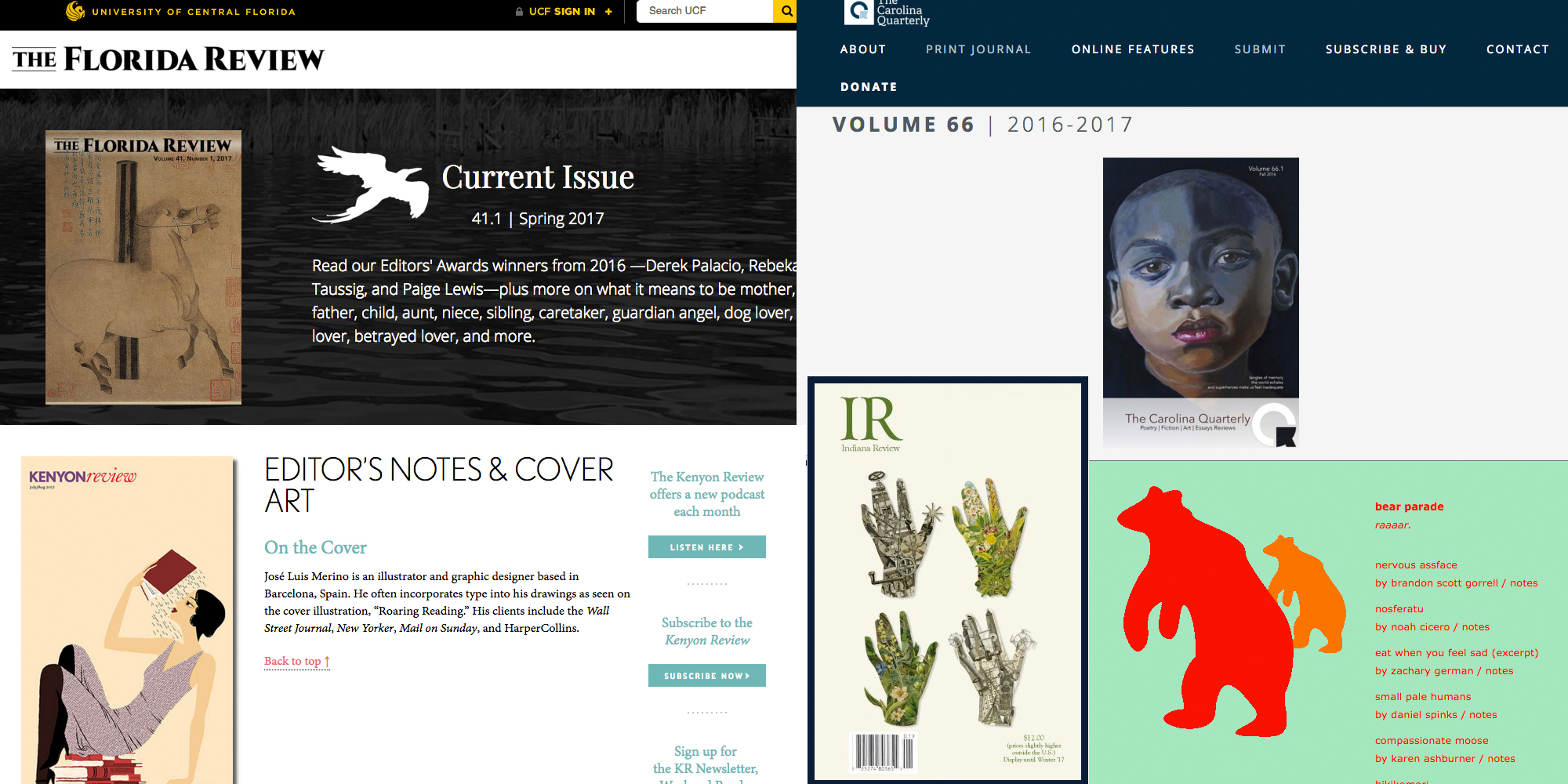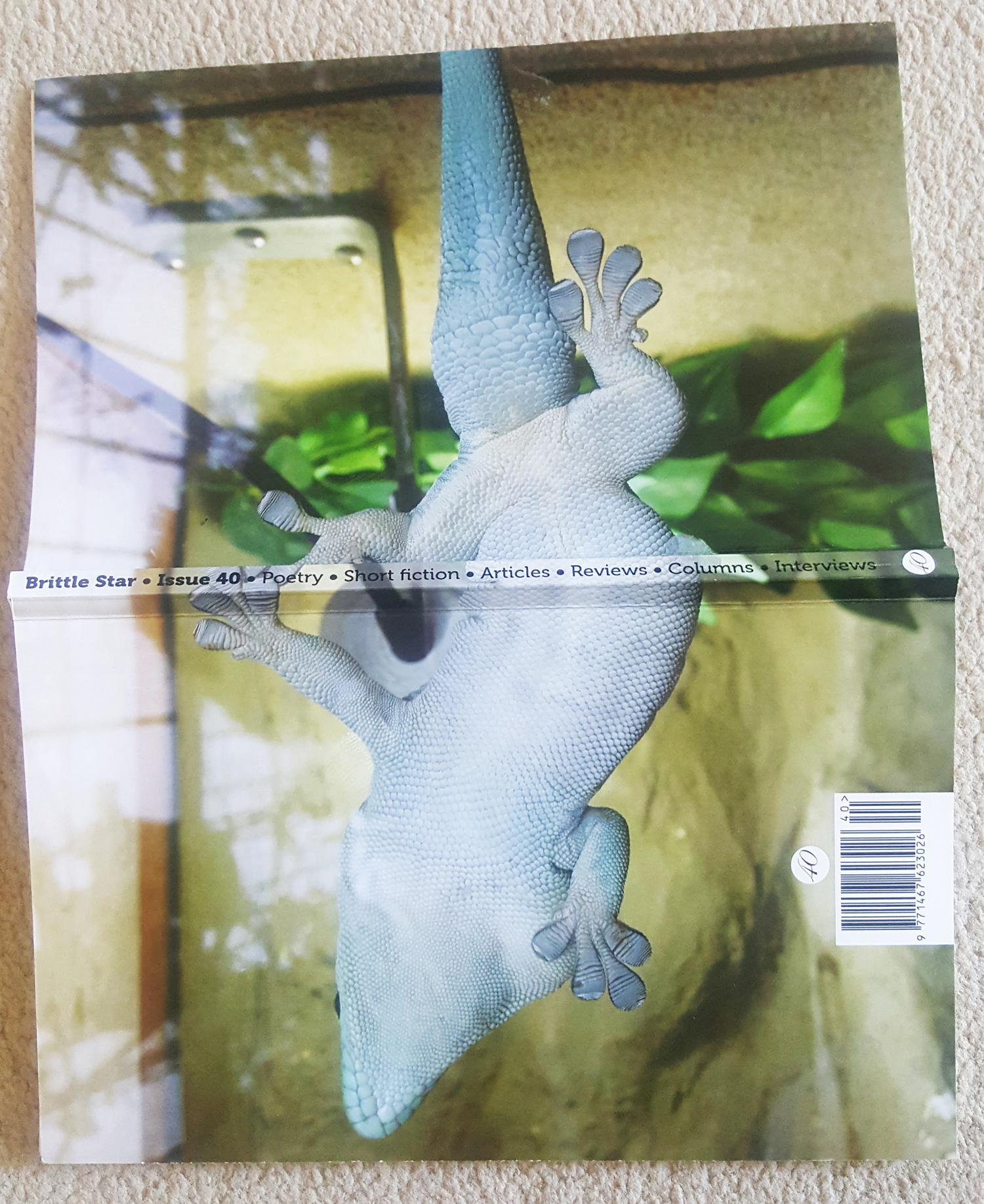In my last post I explained that although I haven’t seriously tried submitting to US poetry journals, I’d like to, and have started doing the research.
What follows here is a list of sixteen journals – obviously far from comprehensive, but it’s a starting point. Many of these publications have large, rich websites with articles, features, blog, podcasts, archives and more. There are also competitions and other opportunities alongside general submissions (which is my focus on here). So do go explore.
I did end up cutting a few of the titles when I discovered they were either not seeking work from abroad, or their websites or submissions processes were just too clunky or broken to manage, or I wasn’t confident they were still active and current.
In general: assume that all magazines require original, previously unpublished work. Always wait for a response before submitting more material. I also recommend reading at least a sample of the work they publish before submitting.
Print only, twice yearly.
Editor: Karen Head
What they say:
Atlanta Review, an international, award-winning poetry journal based in Atlanta, Georgia, has been published biannually since 1994. Located in the Georgia Institute of Technology.
We publish poems, not poets. (All submissions are read blind.)
Our Spring/Summer Issue is guest edited with poems curated from living poets in specific regions or countries in the world.
Poetry submissions:
No more than 5 poems per submission, only one submission per submission period (deadlines June 1st and December 1st) – more details on the Atlanta Review Submittable page. General online submissions fee is $3 (but free if you submit by post.) They aim to respond within 4 months. This is a print-only journal published twice-yearly.
Payment? Unclear.
Online, quarterly.
Senior Editor: Barbara Westwood Diehl (17 other editors are listed)
What they say:
The Baltimore Review was founded by Barbara Westwood Diehl in 1996 as a literary journal publishing short stories and poems, with a mission to showcase the best writing from the Baltimore area, from across the U.S., and beyond. Our mission remains just that.
In 2012, The Baltimore Review began its new life as a quarterly, online literary journal.
Poetry submissions:
Submission periods are August 1 through November 30 and February 1 through May 31. The theme for the Winter 2018 contest is “Food.” Deadline: November 30. Non-theme, non-contest submissions will also be accepted throughout each submission period. Simultaneous submissions are accepted. Response time – from 1 to 4 months.
More details on The Baltimore Review Submittable page.
Payment? Non-contest submissions: a copy of the annual compilation in which the author’s work appears, and a small payment ($40 Amazon gift certificate or $40 through PayPal, if preferred). “We also nominate our contributors’ work for every possible prize, and we send copies of the print compilation to the Best American series and other prize anthologies.”
Sample poem: ‘Bone’, by Leslie Adrienne Miller.
Online, twice yearly.
Senior Editors: Gregory Donovan & Mary Flinn
What they say:
Blackbird: an online journal of literature and the arts offers visitors from around the world outstanding fiction, poetry, nonfiction, and reviews, as well as plays, visual art, new media, and video essays.
We believe that contributors should be paid—as a gesture of respect—as we endeavor to give their work and their lives as artists our sustained support and attention by taking note of their ongoing accomplishments.
Blackbird was founded in 2002 as a joint venture of the Virginia Commonwealth University Department of English and New Virginia Review, Inc.
Poetry submissions:
Send up to 6 poems at a time. Next reading period is from November 15, 2017 to April 15, 2018. Simultaneous submissions acceptable as long as they are ‘indicated as such’. Online submissions preferred – full details here.
Payment? Yes, but unclear what.
Sample poem: ‘I know who you are’, Dana Crum
Online, quarterly.
Editor: Jason Sears
What they say:
By&By Poetry, founded in 2015, aims to provide an eclectic online showcase for both established and up-and-coming poets. We aspire to shape By&By into a celebration of poetry, a place where poets can congregate, read, and be heard….
“By and by” evokes the humid warmth of Southern hymns, the comfort of a grandmother or grandfather, the all-encompassing belief in the future. A term that once denoted a sense of immediacy, “by and by” now implies an eventual hereafter.
Poetry submissions:
Accepted year-round via Submittable (no fee). No more than 5 poems at a time. Include a cover letter, short bio and something about why you think these poems are a good fit with By&By. No payment for publication, but the editors “aim for a speedy seven day turnaround time. If we haven’t reached out to you within a month, feel free to gently prod us into action via Submittable.”
Payment? None.
Sample poem: ‘Pruned’, by Nicole V Bastia
Print, twice yearly. Selected content published online also.
Editor: Moira Marquis
What they say:
The Carolina Quarterly has been publishing established and emergent writers for 65 years. It features a variety of poetry, fiction, essays, reviews, and artwork.
Poetry submissions:
Submissions are accepted year round, both by mail and through Submittable. ($2.50 fee.) No more than 6 poems at a time. Expect four to six months for a decision. Simultaneous submissions are OK but let them know if your work is accepted elsewhere.
Payment? Unclear.
Sample poem: ‘The Mudsuckers’ by Lindsay Wilson
Annual. Thanks to Maggie Sawkins for suggesting this.
Editor: Brian Daldorph
What they say:
Since 1990, Coal City has published 20 annual reviews and 7 collections of poetry. Our contributors are tall, short, male, female, American, foreign, rich, poor, free, imprisoned, discontented, contented, rural, urban, suburban, liberal and not-so-liberal. The traits they share are curiosity, compassion, insight and fierce commitment to good writing.
Poetry submissions:
Coal City Review welcomes submissions of literary poetry and short stories throughout the year. Send up to 6 poems. NB All submissions by SNAIL MAIL ONLY – see the submissions page for details.
Print, twice yearly. Selected content published online also.
Managing Editor: Wayne Miller
Poetry Editors: Brian Barker and Nicky Beer
What they say:
Copper Nickel is the national literary journal housed at the University of Colorado Denver—was founded by poet Jake Adam York in 2002. Work published in Copper Nickel has appeared in the Best American Poetry, Best American Short Stories, and Pushcart Prize anthologies, and has been listed as “notable” in the Best American Essays anthology.
Poetry submissions:
Submissions accepted from August 15 to March 15. Please submit four to six poems at a time. Simultaneous submissions OK but let them know if accepted elsewhere. They try to respond to all submissions within eight weeks, though response times can be longer—particularly in the late spring and summer. Submittable page (no fee).
Payment?
Starting with the spring 2017 issue, Copper Nickel pays $30 per page + contributors copies + a one-year subscription. (Per-page payment could vary slightly from year to year, based on funding.)
They also award a $500 prize per issue – the Editors’ Prize in Poetry -for what they consider to be the most exciting work in each issue, as determined by a vote of in-house editorial staff.
Sample poem: ‘New You’ by Allison Campbell
Print, twice yearly. The sister online magazine is Aquifer.
Editor & Director: Lisa Roney
Poetry editor: Kenneth Hart
What they say:
The Florida Review publishes exciting new work from around the world from writers both emerging and well known. We are not Florida-exclusive, though we acknowledge having a jungle mentality and a preference for grit, and we have provided and continue to offer a home for many Florida writers. We have been in more or less continuous semi-annual print publication since 1975 and have recently (2017) added a new literary supplement in Aquifer: The Florida Review Online, which will feature new literary works on a weekly basis, as well as author interviews, book reviews, and digital storytelling.
We are looking for innovative, luxuriant, insightful human stories—and for things that might surprise us. We like writing that takes risks, affects us deeply, and yet also meets the highest standards of beautiful language and syntax that supports the meaning of the work.
Poetry submissions:
International submissions are welcome via Submittable. Interested in well-crafted poems that sing and take risks—in style or subject. Traditional forms and free verse, any length. Send no more than 5 poems at a time. They strive to respond in 3 to 6 months, though sometimes it takes 8 months. NB read all the submissions guidelines as they are long and specific.
Payment? Starting this year they are awarding modest annual prizes to one non-contest-winner “staff pick” writer in each category (poetry being one).
Sample poem: Two poems by Betsy Sholl (Aquifer)
Twice yearly, print
Editors-in-chief: Tessa Yang, Su Cho
Poetry editors: Anni Liu, Emily Corwin
What they say:
Now in its thirty-ninth year of publication, Indiana Review is a non-profit literary magazine dedicated to showcasing the talents of emerging and established writers. Our mission is to offer the highest quality writing within a wide aesthetic. Works by contributors to IR have been awarded the Pushcart Prize and reprinted in The Pushcart Prize Anthology: Best of the Small Presses, as well as in Best American Short Stories, Best American Poetry, and The O. Henry Prize Stories.
Poetry submissions:
General submission period is September 1, 2017 to October 31, 2017. Send only 3-6 poems per submission. Simultaneous submissions are welcome. However, you must contact them ASAP if your work has been accepted elsewhere. “Please also note that because we are not influenced by cover letters it is perfectly fine to not include a cover letter with your submission.” Response time is usually 1 – 4 months, but may at times be longer. IR accepts less than half of 1% of work submitted.
Payment?
$5.00 per page ($10.00 minimum) and one year’s subscription, beginning with the issue in which their work appears.
Sample poem: This is a print magazine, but poems appear occasionally on the blog.
Print (6 issues a year) and digital version – either instead of print or as an optional add-on to print subscription. You can also buy digital versions individual issues.
KR Online is the online sister publication.
Poetry editor: David Baker
What they say:
Building on a tradition of excellence dating back to 1939, the Kenyon Review has evolved from a distinguished literary magazine to a pre-eminent arts organization. Today, KR is devoted to nurturing, publishing, and celebrating the best in contemporary writing. We’re expanding the community of diverse readers and writers, across the globe, at every stage of their lives.
Poetry Submissions:
Send up to 6 poems. Reading period September 15th through November 1st, 2017. Response time: they aim for within 4 months. NB: All submissions are considered for both the Kenyon Review and KROnline. The two are aesthetically distinct spaces – “we urge our submitters to read and become familiar with both.” The submissions page will contain a live link to Submittable when the window opens.
Payment? Yes, but unclear what.
Sample poem (from KR Online): ‘Guerrilla Theory’ by Kien Lam
Print – two, possibly 3 issues per year
Editor: Philip Fried
What they say:
Founded in 1980, The Manhattan Review has won praise for its balance of American and international poetry, its distinguished interview series, and its many firsts. In the last decade MR has endeavoured to publish the best contemporary British poetry alongside the work of excellent American poets.
Poetry submissions:
Send 3-5 poems, any time. Avoid simultaneous submissions. Contributors from abroad my send by email. See the full guidelines here.
Payment: no mention of any.
Sample poem: ‘Vasari’s Last Supper’ by Rosalind Hudis
Print, monthly
Editor: Don Share
What they say:
Founded in Chicago by Harriet Monroe in 1912, Poetry is the oldest monthly devoted to verse in the English-speaking world.
Poetry submissions:
Send no more than 4 poems at a time. Response can take 7 months (they get a LOT of submissions!) Read the full guidelines on their Submittable page.
Payment:
Payment is made on publication at the rate of $10 per line (with a minimum payment of $300), and $150 per page of prose, for first serial rights. All rights will revert to the author upon publication. Authors will also receive two contributor copies of the issue in which their work appears.
Sample poem: ‘Ode with Interruptions’ by Rick Barot
Print, twice yearly
Editor in chief: John W. Wang
Poetry editor: Katherine Smith
What they say:
Rooted in the nation’s capital’s suburbs, Potomac Review is the antidote to the scripted republic that surrounds it. By taking on D.C.’s values of international inclusion, Potomac Review looks out into the world from its lush Potomac River basin, collecting and absorbing the world’s literary diversity. Potomac Reviewseeks literature from emerging as well as established writers around the globe to facilitate in the literary conversation.
Poetry submissions:
Accepted all year round via their Submittable page. Send up to 3 poems. Simultaneous submissions are welcome but contact them ASAP if your work has been accepted elsewhere. They typically respond within four to six months.
Payment?
Two complimentary copies and a 40% discount for additional copies.
Online, four times a year
Editor: Rachel Marie Patterson
What they say:
We publish poems from established and emerging writers and welcome international submissions. Our taste is eclectic; we encourage submitters to read our past issues before sending work.
We are interested in the interplay between poetry and visual media. Each issue features pairings of poetry and artwork, selected by the editors and contributors.
Poetry submissions:
General submissions via Submittable open October 1 through June 30. Send 3 – 5 poems. They aim to respond within a month. From July to September they read submissions for the Coniston Prize, this year judged by Dorothea Lasky.
Sample poem: ‘Biography’ by Erin Malone
Print, quarterly. All poems also published on the blog, a poem a day.
Editor: Timothy Green
What they say:
….more than anything, our goal is to promote a community of active poets. That means we care as much about submitters as subscribers. Lawyers, landscapers, homemakers, and Pulitzer Prize winners are all treated the same—and we’ve published them all. We only occasionally solicit work, and for representational balance, not prestige. At Rattle, anything always goes. If a poem is accessible, interesting, moving, and memorable, if it makes you laugh or cry, then it’s the kind of poem that rattles around inside you for years, and it’s our kind of poem.
Poetry submissions:
Submit year-round via Submittable. Send up to 4 poems. No fees to submit. Simultaneous submissions are encouraged – “if another journal beats us to the punch, congratulations!” Detailed submissions guidelines are here.
Payment?
Contributors in print receive $100/poem and a complimentary one-year subscription to the magazine. Online contributors receive $50/poem.
All submissions are automatically considered for the annual Neil Postman Award for Metaphor, a $1,000 prize judged by the editors.
Sample poem: ‘This has nothing to do with willpower’ by Ted Jonathan
Print, twice yearly, publishing long form only
Editor in Chief: Andrew Feld
What they say:
The Seattle Review is a print journal wholly committed to the publication of longer works of poetry, novellas, and lyric essays. It is our belief that this format offers a unique venue for the publication of significant and risk-taking works by both new and established writers.
Poetry submissions:
Accepted all year round via Submittable. There’s a $3 reading fee from June 1 to September 30. A ‘long’ poem means at least 10 pages in length, but there are other criteria – best to read the detailed guidelines here.
Payment? Contributors will receive two copies of the issue in which their work appears, and a year’s subscription to the Seattle Review.
Sample poem: poems occasionally published on the blog.
At this point I rather ran out of steam
– but wanted to mention a couple more briefly, even though they didn’t make this particular cut:
Tarpaulin Sky – chaotic website but brilliant and very funny (and that’s just the ‘subscribe to our press’ page). Submissions guidelines are here, although it sounds like they’re not open at the moment. Lots of great alternative, smart & interesting poetry & visuals on the site.
CutBank – I really liked the look of this (print and online) journal based in Montana, but it sounded like they perhaps aren’t looking for submissions from overseas. They say they are “global in scope, but with a regional bias.”
At some point I’ll review & update this list and would be happy to add to it – if you have any more suggestions please leave them in the comments.
Also, if you do submit to any of them let us know how it was for you… and I’ll do the same. Thanks.
